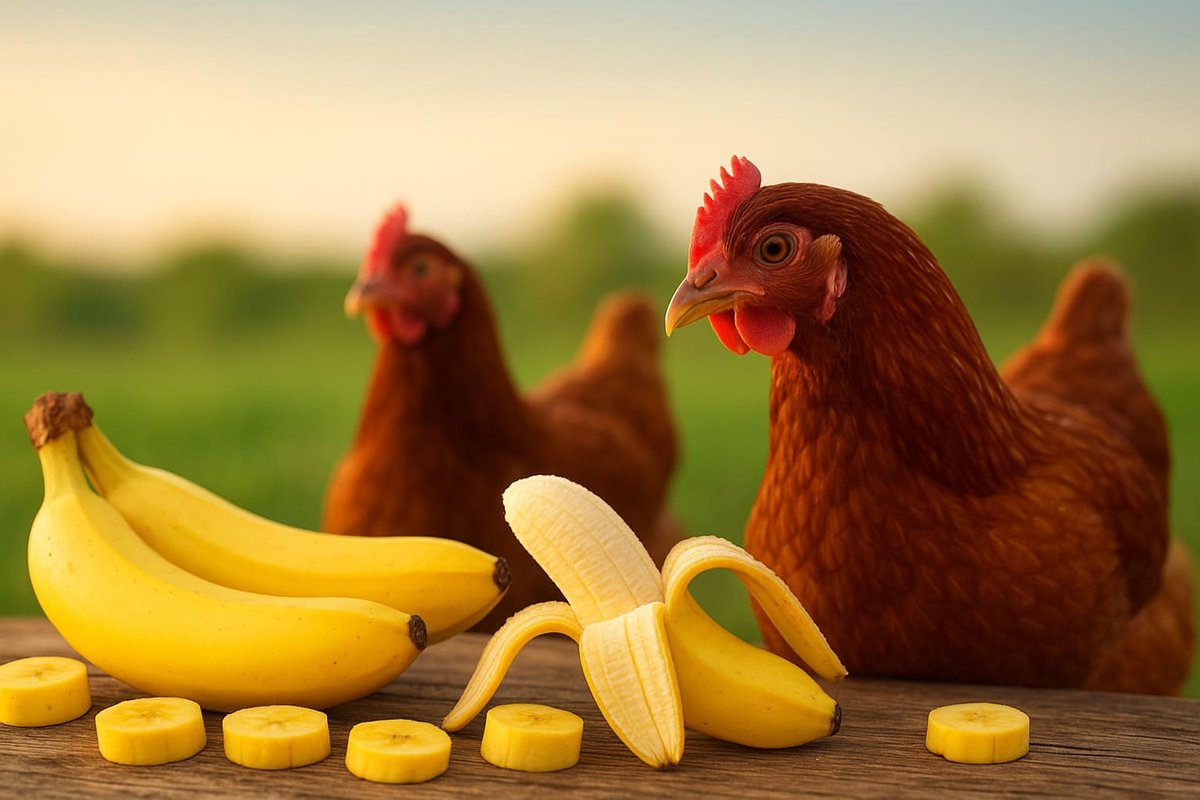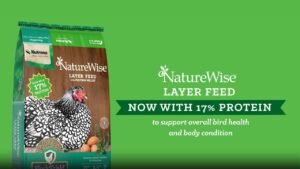Standing in your kitchen with a bunch of overripe, brown bananas, you’ve probably wondered if your backyard flock can help you avoid food waste. You hate throwing food away, and your hens always seem hungry. But are bananas actually safe for them?
The short answer is yes, chickens can eat bananas, and they can even eat the banana peels. However, there are some very important rules you need to follow. Bananas are sugary, and peels can be tough to digest without the right preparation.
Bananas are safe for chickens when fed properly. For a comprehensive overview of all foods your flock can enjoy, check out our complete guide to chicken nutrition.
This guide covers everything American backyard chicken owners need to know about safely feeding bananas to their flock, from baby chicks to laying hens. I’ll share what I’ve learned from years of keeping chickens, along with advice based on veterinary recommendations to keep your flock safe.
Can Chickens Eat Bananas? What You Need to Know First

When asking “can chickens eat bananas,” the answer is a definite yes. My Rhode Island Reds absolutely go crazy for them. Bananas contain no toxic compounds that will hurt your birds. In fact, chickens usually love the sweet taste and soft texture.
Before feeding any kitchen scraps to your flock, it is also smart to understand the legality of feeding scraps in your specific area, though bananas are generally fine.
However, bananas must be a treat, not a meal. Because they are high in sugar and low in protein, they shouldn’t make up a large part of your flock’s diet.
Key Feeding Facts:
- Portion Size: 1-2 tablespoons per adult chicken maximum.
- Frequency: No more than 1-2 times per week.
- The Golden Rule: Treats should make up no more than 10% of their daily diet (about 2 tablespoons max).
Standing in your kitchen with overripe bananas, you’re reducing food waste while treating your flock. Learn more about other kitchen scraps safe for chickens to add variety to their diet.
Watch your flock scramble when they see you approaching with a banana—they know what’s coming! It’s a fun way to bond with your birds, as long as you don’t overdo it.
The Banana Peel Question: Can Chickens Eat Them?
This is the most common question I get: “Can chickens eat banana peels, or just the fruit?”
Technically, yes, chickens can eat banana peels. But there is a catch. Peels are very fibrous and tough. Since chickens don’t have teeth, they can struggle to tear apart a whole peel. If you just throw a whole peel in the run, they will likely peck at it for a minute and then ignore it.
How to Prepare Banana Peels for Chicken Feed:
- Use Organic Bananas Only: Conventional banana skins are among the most heavily treated fruits for international shipping, often covered in fungicides and ripening agents. The USDA doesn’t require testing for pesticides on banana peels since humans don’t typically eat them. This means conventional peels may have higher residue levels than the inside fruit. For American backyard chicken keepers, this makes organic bananas essential if feeding peels.
- Wash Thoroughly: Scrub the skin to remove stickers and residue.
- Boil Them: Boiling peels for 20-30 minutes softens those tough fibers.
- Chop It Up: Cut the boiled peel into small, bite-sized pieces.
Pro Tip: Honestly? Most chicken keepers (myself included) feed the banana fruit to their flock and compost the peels. It’s much less work, and the chickens prefer the sweeter flesh anyway.
Note: This article provides general information about feeding treats to backyard chickens. For specific health concerns or if your chicken shows signs of illness, always consult a poultry veterinarian. The CDC also provides guidelines on staying healthy around backyard poultry.
Why Bananas Are Good for Your Backyard Flock
Feeding bananas to chickens isn’t just about getting rid of leftovers. When fed in moderation, they offer some great health benefits.
Understanding basic poultry nutrition is key to a healthy flock. Here is a breakdown of why this fruit is a solid chicken treat:
| Nutrient | Benefit for Your Chickens |
|---|---|
| Potassium | Helps muscle function and can help prevent thin eggshells. |
| Fiber | Good for gut health and digestion. |
| Magnesium | Important for bone strength and metabolism. |
| Vitamin B6 | Supports healthy feather growth and nervous system. |
| Water Content | Excellent for hydration during hot US summers. |
I’ve noticed my hens seem a bit more energetic when they get a varied diet that includes fruits like bananas. Plus, the potassium is great for electrolytes during heat waves.
The Risks: When Bananas Become Problematic
While we know chickens eating bananas is generally safe, too much of a good thing is bad. You might be wondering, can bananas cause digestive issues in chickens? Yes, they can.
Here are the main risks:
- Sugar Overload: Bananas are sugary. Too much sugar can lead to obesity in your flock. Overweight hens often stop laying eggs and can suffer from fatty liver issues.
- Digestive Upset: If a chicken eats too much banana at once, the sugar can cause diarrhea. If you see loose droppings after feeding bananas, learn how to identify and treat digestive issues in chickens.
- Crop Impaction: This is mostly a risk with large pieces of peel. The crop is the pouch where chickens store food before digestion. Long, stringy fibers can get stuck there.
- Messy Beaks: The sticky texture can coat their beaks. You might see them wiping their beaks on the ground or their feathers to clean it off.
Warning: Never feed moldy or rotten bananas to your flock. If it has fuzzy mold, throw it in the trash, not the coop. Mold can produce toxins that are deadly to poultry.
What Age Can Chickens Eat Bananas?
Feeding treats to baby chicks is different than feeding adult layers. Their digestive systems are tiny and developing.
Baby Chicks (Under 8 Weeks)
Can chicks eat bananas? It is best to wait. Some sources suggest 6 weeks minimum, but I personally wait until 8 weeks to be safe.
Here is why:
- Protein Priority: Chicks need a high-protein starter feed to grow feathers and bones. The University of Florida IFAS Extension emphasizes that chicks require starter feeds with 20-24% protein for proper development. Bananas have very little protein.
- Tiny Crops: A chick’s crop is very small. If they fill up on bananas, they won’t have room for their nutritionally complete feed.
- Health Risks: Improper feeding (like too many treats) can disrupt calcium balance. The Merck Veterinary Manual warns that nutritional imbalances can lead to serious issues like kidney damage in developing birds.
- Choking Hazard: The sticky texture can be hard for tiny beaks to manage.
Baby chicks under 8 weeks have specific dietary needs. If you’re new to raising baby chicks, make sure you have the essential chick supplies and proper brooder setup before introducing treats.
Adult Chickens (12+ Weeks)
Once your birds are fully feathered and near laying age, they can handle feeding bananas to chickens regularly.
- Portion: 1-2 tablespoons per bird maximum.
- Frequency: Once or twice a week.
- Prep: Slices or chunks are fine.
How to Feed Chickens Bananas: Step-by-Step Methods
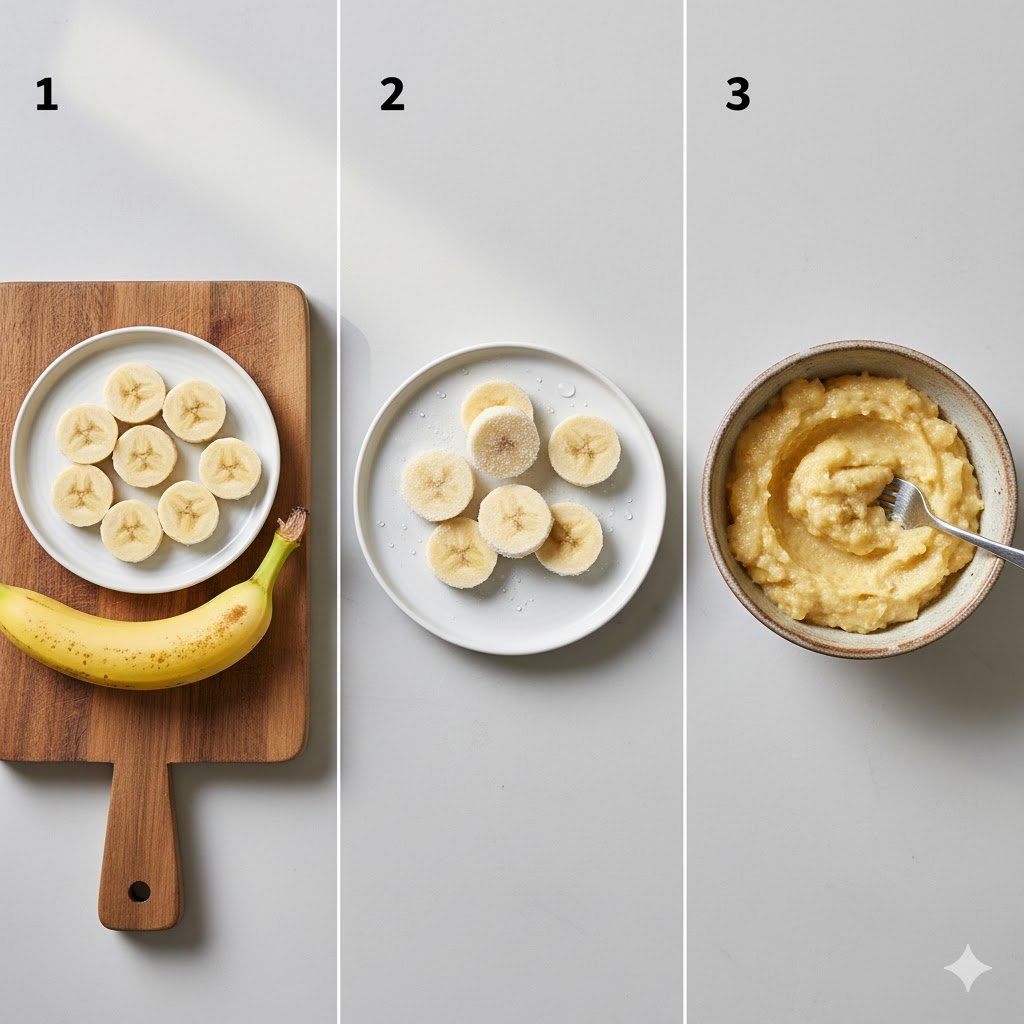
There are a few ways to serve this treat depending on the weather and your flock’s personality.
Method 1: Fresh Banana Slices (Easiest)
This is the standard way to do it.
- Peel a ripe yellow or brown banana.
- Slice it into round coins or chunks (about 1/4 inch thick).
- Scatter the pieces in the grass or run. Do not put them inside the coop bedding—it gets too messy.
- Scattering ensures even the shy chickens get a piece, not just the bossy hens at the top of the pecking order.
Method 2: Frozen Banana Treats (Summer Favorite)
This is a lifesaver for flocks in hot states like Texas or Florida.
- Slice bananas into rounds.
- Put them on a tray and freeze for 2 hours.
- Toss the frozen “pucks” into the yard.
- The cold treat helps lower their body temperature, and because it’s frozen, they peck at it slowly. This keeps them occupied longer.
Method 3: Mashed Banana (For Timid Eaters)
If you have a rescue bird or a shy eater:
- Mash the banana in a bowl.
- Mix it with a little bit of their regular layer feed or some oats.
- Serve it in a dish. This is less intimidating than big chunks.
Brown Bananas, Green Bananas, and Ripeness Guidelines
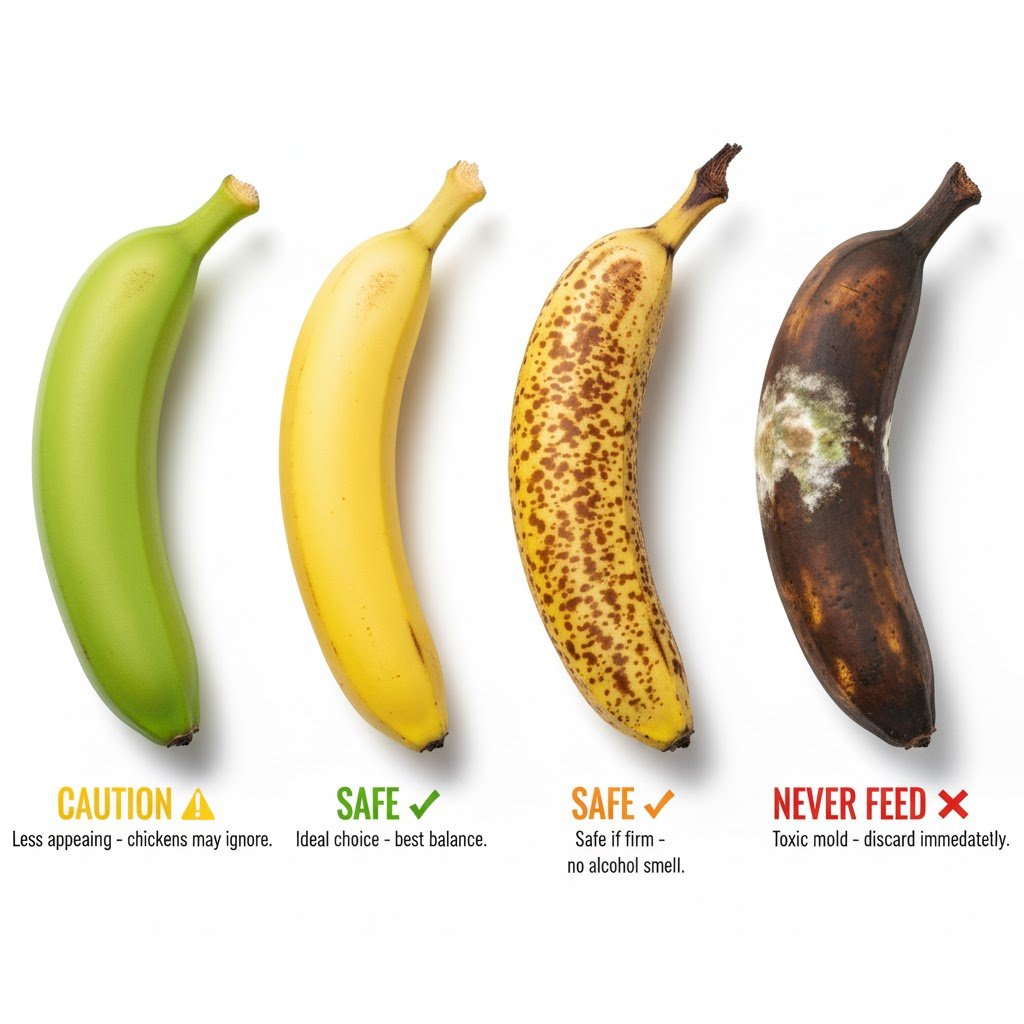
Can chickens eat brown bananas? This depends on how ripe they are:
- ✅ Brown-skinned but firm inside: Most chicken keepers (including myself) feed these regularly. Chickens love the sweeter taste.
- ⚠️ Very mushy or fermenting: According to Dr. Bocchine, a poultry veterinarian, overripe bananas that are very soft can cause digestive upset and attract fruit flies to your coop. If the banana smells like alcohol or wine, it’s fermenting—compost it instead.
- ❌ Moldy or rotten: Never feed these. Mold produces toxins harmful to chickens.
Other Ripeness Stages:
- Ripe (Yellow): The standard choice. Easy to slice and handle.
- Unripe (Green): Can chickens eat green bananas? Technically yes, but they are harder and less sweet. Your chickens might turn their beaks up at them because they lack flavor.
How Much Banana Can I Give My Chickens? Exact Portions
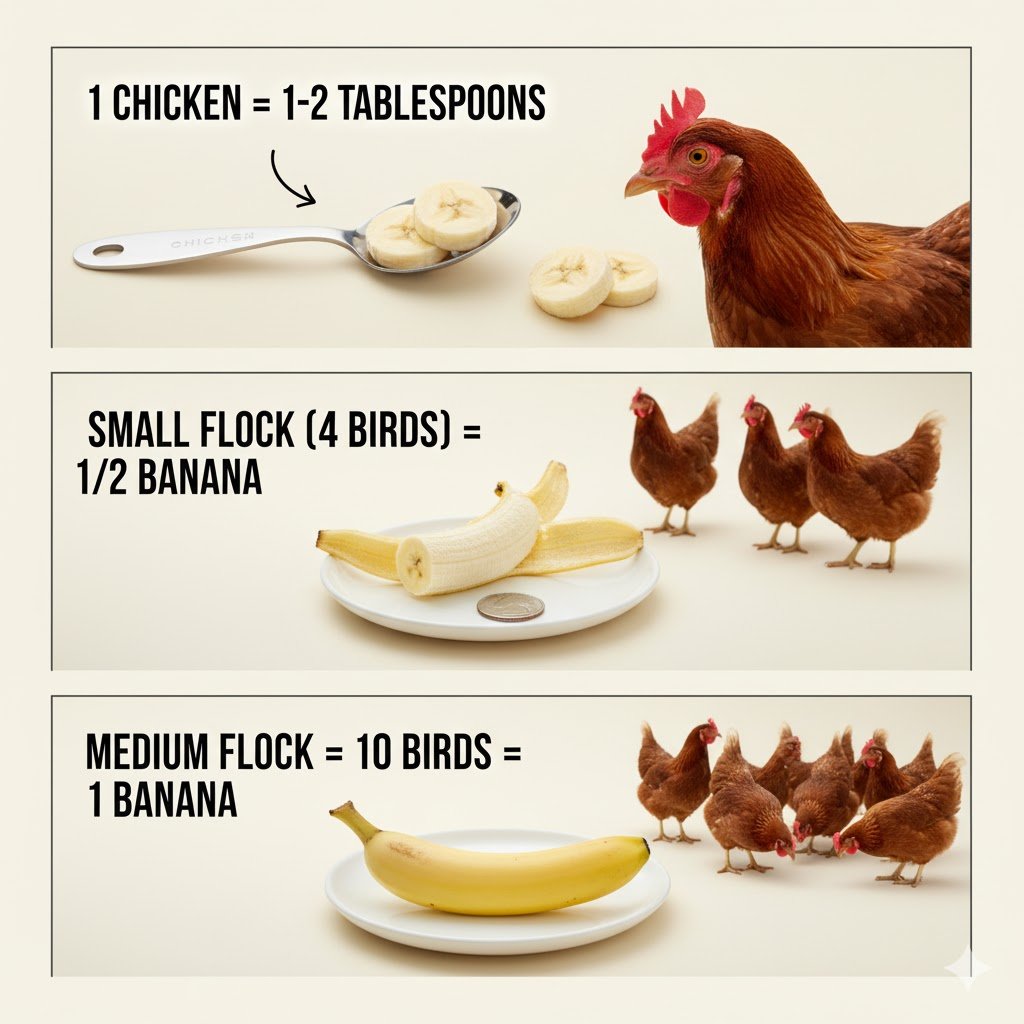
Portion control is the difference between a healthy treat and a health problem.
The Math:
- 1 Chicken: 1-2 Tablespoons maximum.
- Small Flock (4 birds): Half a banana.
- Medium Flock (10 birds): One whole banana.
If you throw five bananas to three chickens, you are going to have sick birds. Treats should make up no more than 10% of daily intake. For example, if your chicken eats 1/4 pound (4 ounces) of feed daily, treats should be no more than 0.4 ounces total—about 2 tablespoons. Since one banana serving is already 1-2 tablespoons, you can see why bananas shouldn’t be daily. To avoid overfeeding, learn how to create a balanced feeding schedule for your flock. Some experts recommend limiting bananas specifically to 5% of weekly intake due to high sugar content. The other 90% must be their scientifically formulated feed to ensure they lay strong eggs.
Expert sources like the University of Illinois College of Veterinary Medicine and Oregon State University Extension strongly emphasize adhering to these moderation guidelines to prevent obesity and decreased egg production.
Signs of Overfeeding Bananas
If you suspect you’ve been too generous with the treats, watch for these specific symptoms. This addresses the common concern: can bananas cause digestive issues in chickens? Yes, if overfed.
- Loose, runny droppings (diarrhea): High sugar content can disrupt their digestion quickly.
- Reduced egg production: Often visible within 3-5 days if their protein intake drops because they are filling up on fruit.
- Chickens ignoring their layer feed: If they wait for treats instead of eating pellets, they aren’t getting essential calcium and protein.
- Visible weight gain: This can become apparent over 2-3 weeks. Overweight hens are prone to health issues and stopped laying.
- Lethargic behavior: If a chicken seems slow or sleepy, it may be suffering from significant digestive upset.
Bananas vs. Other Fruits: Making Smart Choices
Bananas are a favorite treat, but they shouldn’t be the only tool in your treat bucket. To maintain a healthy flock, it is crucial to understand how bananas compare nutritionally to other common kitchen scraps and garden goodies. Variety isn’t just the spice of life; it’s the key to avian health.
While bananas are excellent for a quick carbohydrate energy boost and potassium, they lack the calcium found in leafy greens or the hydration power of melons. By rotating these treats, you cover different nutritional bases. For example, leafy greens provide Vitamin K for blood clotting and bone health, while berries offer antioxidants that support immune function. Mealworms, unlike fruits, provide the essential protein needed for feather regrowth and egg laying.
Looking for other seasonal treats? Chickens can also eat pumpkins, which provide different nutritional benefits, especially in the fall.
Here is a detailed comparison to help you plan your weekly treat rotation:
| Treat Type | Nutritional Highlight | Sugar Content | Best Use Case | Frequency |
|---|---|---|---|---|
| Bananas | Potassium & B6 | High | Quick energy & muscle health | 1-2x weekly |
| Watermelon | Electrolytes & Water | Medium | Intense hydration during heat waves | 2-3x weekly (Summer) |
| Leafy Greens | Calcium & Vitamin K | Very Low | Strong eggshells & daily health | Daily (in moderation) |
| Blueberries | Antioxidants | Medium | Immune system boost | 1-2x weekly |
| Mealworms | Protein (50%+) | None | Molting & winter warmth | 2-3x weekly |
| Pumpkin Seeds | Vitamin E & Fats | Low | Natural deworming aid (preventative) | 1x weekly |
Better Alternatives: If you need specific nutritional solutions, consider these swaps:
- ✅ For Overweight Hens: Skip the high-sugar banana. Instead, try leafy greens like kale, spinach, or Romaine lettuce. These mimic their natural foraging diet and are low in calories.
- ✅ For Molting Birds: Swap the banana for mealworms or black oil sunflower seeds. These provide the protein boost they desperately need to regrow feathers.
- ✅ For Maximum Egg Production: While bananas provide potassium, treats that boost egg production like mealworms offer even greater laying benefits.
Rotation Strategy: I like to rotate treats to prevent boredom and nutrient gaps. A balanced weekly schedule might look like this:
- Monday: Leafy greens (Kale or Cabbage on a string).
- Wednesday: Hydrating fruit (Watermelon or Cucumber).
- Friday: High-energy treat (Bananas or Berries).
- Sunday: Protein snack (Mealworms or Scrambled Eggs).
Can Chickens Eat Banana Bread, Banana Chips, and Banana Peppers?
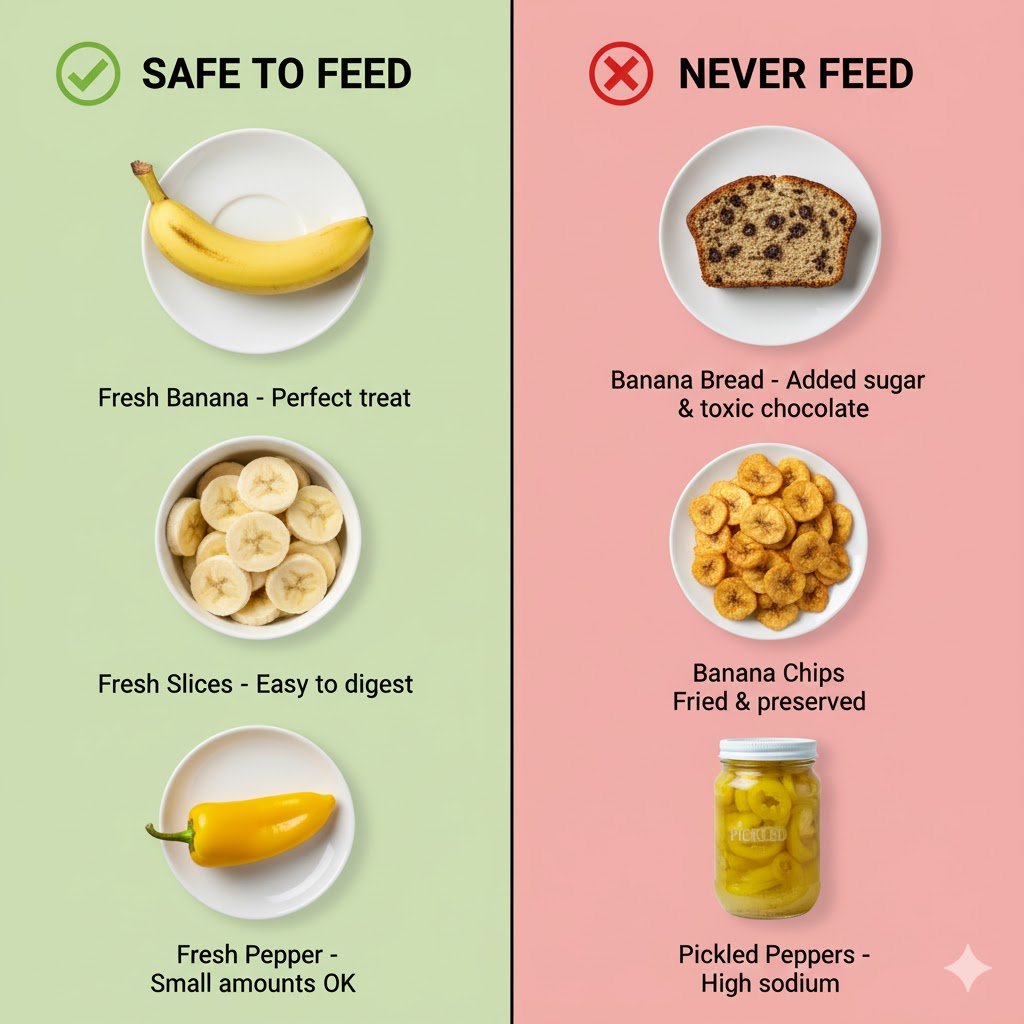
People often ask about banana-flavored human foods. Here is the breakdown on what to avoid.
Can Chickens Eat Banana Bread?
❌ NO. You should avoid feeding banana bread to chickens. It contains added sugar, processed flour, and often butter or oil. If it has chocolate chips, it is toxic. Even “healthy” banana bread is junk food for a bird.
Can Chickens Eat Banana Chips?
❌ NO. Store-bought banana chips are usually fried in oil and covered in sugar or preservatives to keep them crunchy. They are too hard and unhealthy.
Can Chickens Eat Banana Peppers?
⚠️ YES (with caution). Banana peppers aren’t related to bananas; they are peppers. Chickens can eat fresh banana peppers in moderation. However, never feed pickled banana peppers from a jar. The vinegar and massive sodium (salt) content are dangerous for chickens’ kidneys.
Feeding Bananas Across Different US Climates and Seasons
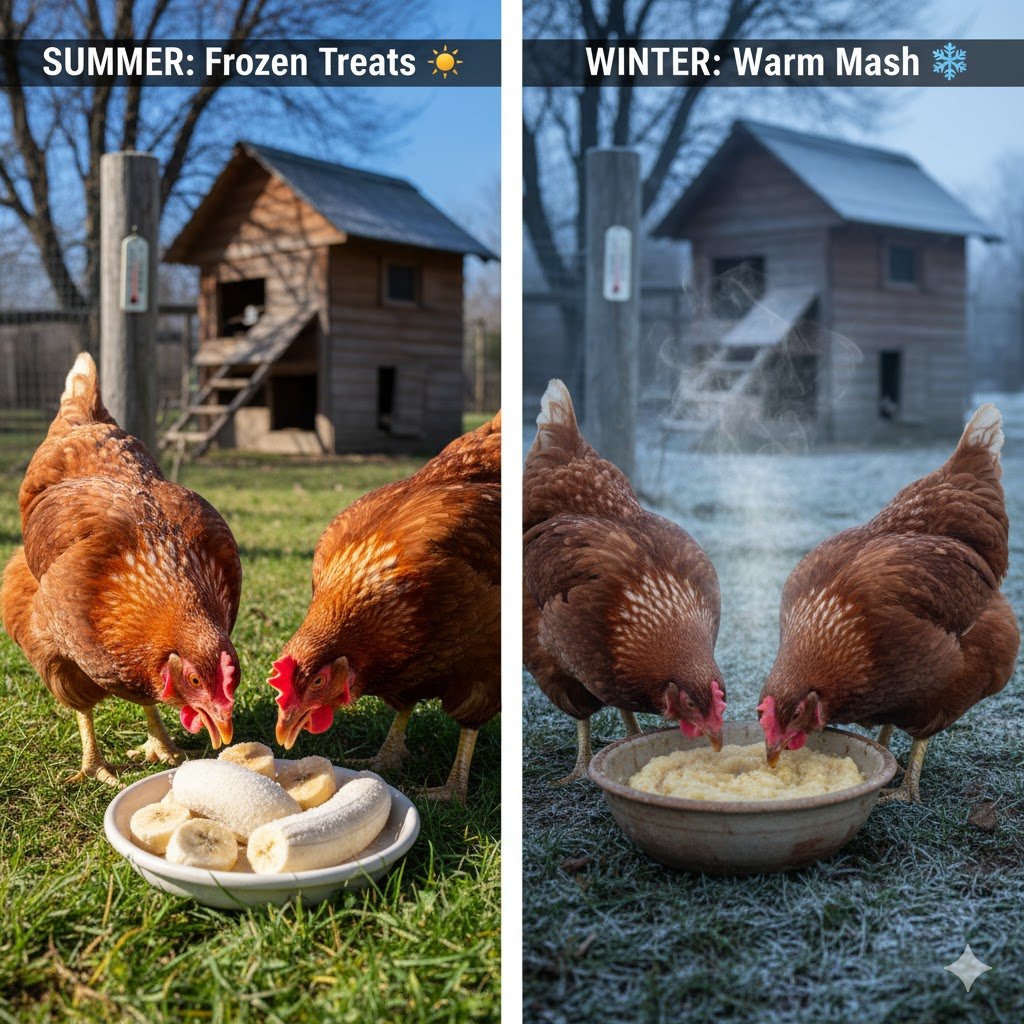
Where you live in the US determines how you should feed bananas, but when you feed them is just as important. A chicken’s dietary needs change with the calendar.
Seasonal Feeding Strategies: A Month-by-Month Guide
- Spring (March – May): Focus on Foraging As the ground thaws and grass grows, your chickens will be foraging for bugs and greens.
- Strategy: Limit bananas to once a week. They are getting plenty of natural sugars and carbs from young shoots and insects.
- Preparation: Serve fresh slices to encourage activity.
- Summer (June – August): Hydration Station Heat stress is a major killer of backyard poultry.
- Strategy: Increase banana frequency slightly if used for cooling, but pair with watery fruits.
- Preparation: Frozen bananas are essential. Frozen banana slices are just one way to help your flock beat the heat. Discover more strategies for keeping chickens cool in summer.
- Warning: In high heat (above 90°F), sugar can cause fermentation in the crop faster. Remove uneaten treats within 1 hour.
- Autumn (September – November): Molting Season Chickens lose their feathers and stop laying eggs. They need massive amounts of protein (18-20%).
- Strategy: Reduce banana feeding. Bananas are low in protein (only about 1%). Filling a crop with banana means less room for high-protein grower feed or mealworms.
- Preparation: If you do feed bananas, roll the banana chunks in dried mealworms or sunflower seeds to add a protein punch.
- Winter (December – February): Caloric Warmth Chickens burn calories just to stay warm.
- Strategy: Carbs are good now! The quick energy from natural sugar helps fuel their metabolism.
- Preparation: Do not feed frozen treats. Instead, make a warm mash. Mix crushed banana with warm water and oatmeal or corn. This “chicken porridge” warms them from the inside out on freezing mornings.
Homesteading on a Budget: Sourcing Free Bananas
Raising chickens can get expensive, but treats shouldn’t break the bank. Since chickens actually prefer overripe bananas that humans throw away, you can often get them for free if you know where to ask.
1. Grocery Store “Cull” Bins: Most grocery stores have a policy for produce that is too brown to sell but perfectly safe to eat. Speak to the produce manager at your local supermarket. Ask if they have a “cull box” or “compost bin” for overripe fruit. Many managers are happy to set aside a box of brown bananas for you once a week rather than throwing them in the composter.
2. Smoothie Shops and Cafes: Juice bars and coffee shops go through hundreds of bananas a day. While they use the fruit, they often discard single bananas that have gotten “too brown” over the weekend. Additionally, if you compost, ask for their buckets of banana peels. While you shouldn’t feed piles of raw peels to chickens, they are gold for your compost pile, which eventually feeds your garden and your flock.
3. Food Pantries: Local food banks often receive donations of perishable produce that they can’t distribute fast enough. If you volunteer or develop a relationship with them, they may allow you to take the “spoiled” produce (like black bananas) that isn’t fit for human boxes but is a gourmet feast for poultry.
Always check free sources for mold. Free food is great, but a moldy banana is never worth the risk of a vet bill.
Solving Banana-Feeding Problems
Sometimes things don’t go as planned. Here is how to troubleshoot.
Problem 1: Chickens Won’t Eat It
- Solution: Your bananas might be under-ripe. Wait until they are brown and smelly. Or, try mashing them. Some chickens are just picky eaters!
Problem 2: Messy Coop
- Solution: Never feed bananas inside the coop. Always toss them in the run or free-range area. The sticky residue attracts bedding and poop, creating a bacterial mess.
Problem 3: Digestive Upset
- Solution: If you see loose poop after “Banana Friday,” you fed too much. Skip treats for a week, offer plenty of water and grit, and try again later with half the portion size.
Problem 4: Aggression
- Solution: If your hens fight over the banana, you aren’t spreading it out enough. Don’t drop it in one pile. Walk in a line and drop pieces every few feet so everyone gets a chance to eat in peace.
Frequently Asked Questions: Chickens and Bananas
Q: Can chickens eat banana stems?
A: No, I wouldn’t recommend it. The stem (the thick part connecting the fruit to the bunch) is extremely fibrous and hard. It can cause crop impaction.
Q: Can chickens eat banana leaves?
A: Yes, banana leaves are safe, but they aren’t very nutritious. Most chickens will ignore them unless they are very bored.
Q: What’s better – giving banana peels to chickens or composting them?
A: Composting is more practical. Peels require boiling and chopping to be safe and appetizing. Composting them creates rich soil for your garden, which can then grow greens for your chickens. It’s a win-win.
Q: Can roosters eat bananas?
A: Yes, roosters can eat bananas just like hens. Follow the same portion rules.
Q: Will bananas change egg taste or color?
A: No, bananas won’t make eggs taste like fruit. However, the nutrients might make the yolks a slightly richer yellow, which is great!
Q: Can I feed bananas during molting season?
A: You can, but there are better options. During molt (when they lose feathers), chickens need protein to regrow plumage. Bananas are low protein. Mealworms or sunflower seeds are better treats during a molt.
Q: Do organic vs. conventional bananas matter?
A: For the inside fruit, it matters less because the peel protects it. But if you plan on feeding banana peels, organic is mandatory to avoid feeding your birds pesticides.
Expert Tips for Feeding Bananas to Your Backyard Flock
After years of raising backyard poultry, here are a few tips to make life easier:
- The Freezer Stockpile: Whenever a banana goes brown on my counter and I don’t have time to bake, I peel it and toss it in a “Chicken Bag” in the freezer. I always have treats ready for hot days.
- Source Free Treats: Ask your local smoothie shop or small grocer what they do with their “ugly” bananas. Many are happy to give them to you for free for your livestock.
- The Distraction Technique: If I need to inspect a specific hen or check the coop for repairs, I toss a banana to the far side of the run. The whole flock runs over there, giving me 5 minutes of peace to work.
- Winter Wellness: In the winter, I like to mix mashed banana with a little plain yogurt. The probiotics in the yogurt plus the energy from the banana is a great health booster when they can’t forage for bugs.
Feeding bananas to your chickens is safe, fun, and reduces waste. Just remember: peel it, slice it, keep portions small, and watch your flock enjoy their tropical treat!

Oladepo Babatunde is the founder of ChickenStarter.com. He is a backyard chicken keeper and educator who specializes in helping beginners raise healthy flocks, particularly in warm climates. His expertise comes from years of hands-on experience building coops, treating common chicken ailments, and solving flock management issues. His own happy hens are a testament to his methods, laying 25-30 eggs weekly.
